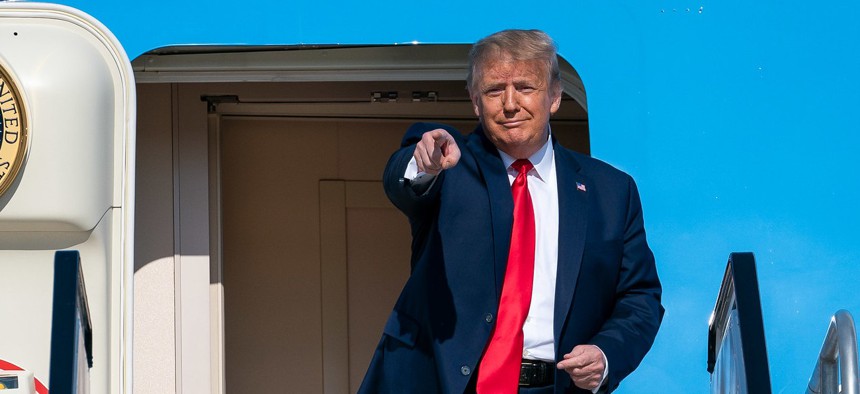White House Advisor Sought Legal Opinion to Allow Trump to Fire Anyone In Government
A recently published internal White House document from early in the Trump administration proved to be a road map for the White House’s efforts to weaken unions and cut federal employee pay and benefits.
A recently published internal document from 2017 on federal employment issues revealed that a top Trump aide encouraged White House lawyers to examine whether the president has an inherent constitutional authority to fire whomever he pleases in government, seeking to deem civil service and merit systems protections unconstitutional.
A 19-page memo written by James Sherk, then a labor policy advisor on the Domestic Policy Council, provides a roadmap for controversial actions taken by the Trump White House in recent years, and could offer insight into future initiatives. Sherk is now special assistant to the president for domestic policy.
The New York Times first reported on the existence of the document, although it was not publicly available in full until this week, when it was published by The Daily Beast and the Project on Government Oversight.
In the memo, Sherk suggested that the White House should examine a so-called “Constitutional option,” a legal theory that the president has power through Article II to dismiss any federal employee for any reason.
“This implies civil service legislation and union contracts impeding that authority are unconstitutional,” he wrote. “If so, the president could issue an executive order outlining a streamlined new process for dismissing federal employees. This would facilitate the swift removal of poor performers.”
A look elsewhere in the document shows that from the earliest days of the Trump administration, officials have sought ways to weaken federal sector unions and reduce the pay, benefits and workforce protections of federal employees.
Many elements of the memo became federal policy nearly unchanged from how Sherk first proposed them. For instance, Sherk called for a series of executive orders on collective bargaining in the federal government, specifically limiting the subjects upon which unions may negotiate with agencies, encouraging federal agencies to fire poor performers, and limiting union employees’ ability to use official time to perform representational duties.
Roughly a year after the document was drafted, President Trump signed three executive orders on these topics. One sought to make it easier for agencies to fire federal workers, another streamlined the collective bargaining process and removed a series of topics like performance reviews and disciplinary actions from grievance procedures, and a third drastically reduced the amount of time union workers can spend on official time.
Another initiative originating with the 2017 memo came to fruition more recently, albeit watered down. Last January, Trump delegated his authority to exempt the Defense Department from the law governing collective bargaining in the federal government to Defense Secretary Mark Esper in a memo first uncovered by Government Executive. To date, Esper has not exercised this new authority.
But in the document, Sherk contemplated a much broader application of the president’s authority to exempt national security agencies from federal labor law.
“Government unions impede the efficiency of federal operations and direct the government to put the interests of government employees first,” he wrote. “Curtailing collective bargaining in government serves the public good . . . POTUS should issue an EO exempting DOD from collective bargaining. Explore the possibility of adding VA to this list. Possibly parts of DHS, State and OPM. Our [TSA] administrator should cease collective bargaining with security screeners.”
Additionally, the document accuses federal employee unions of filing “abusive” unfair labor practice charges, arguing that many complaints should instead be subject to arbitration. His solution to this was for the Federal Labor Relations Authority to refuse to hear cases that could be sent to arbitration, or to “abolish the FLRA [general counsel].” The general counsel position has remained vacant since 2017, effectively halting all unfair labor practice proceedings unless they first arise through an arbitrated grievance.
Sherk’s memo also appears to have set the White House’s agenda when it comes to federal pay and benefits. In the document, he called for a pay freeze every year “until Congress sends [Trump] legislation comprehensively overhauling federal compensation,” although the president abandoned this approach in his 2020 alternative pay plan and fiscal 2021 budget proposal.
The document also calls for a series of cuts to federal employee benefits, most of which have featured heavily in each of the Trump administration’s budget proposals but have failed to gain traction in Congress. Sherk called for eliminating the Federal Employees Retirement System for new employees in favor of increasing the employer match to the Thrift Savings Plan, increasing FERS contribution rates for existing federal employees, and eliminating the “requirement that federal employees pay 25% of their health care premiums,” which he suggested would encourage “greater competition on cost.”








